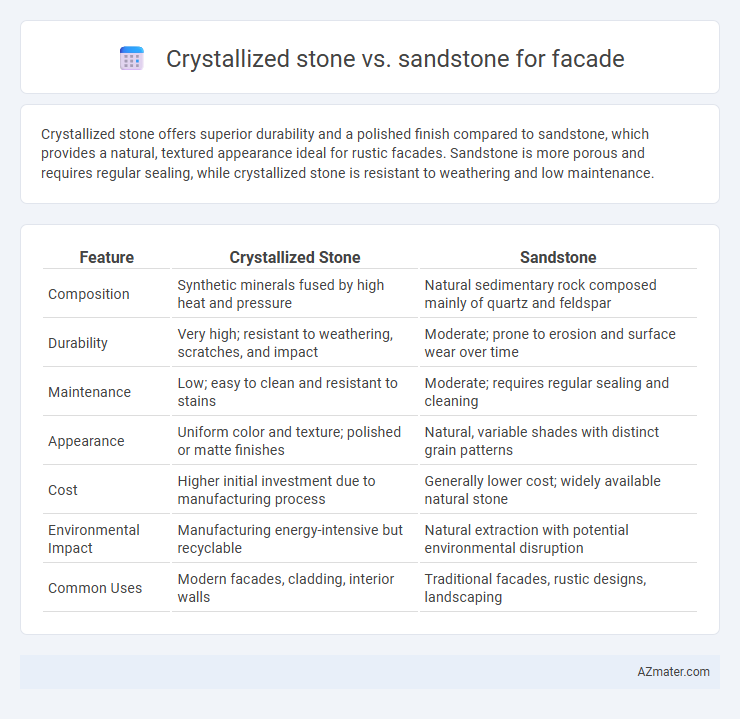Crystallized stone offers superior durability and a polished finish compared to sandstone, which provides a natural, textured appearance ideal for rustic facades. Sandstone is more porous and requires regular sealing, while crystallized stone is resistant to weathering and low maintenance.
Table of Comparison
| Feature | Crystallized Stone | Sandstone |
|---|---|---|
| Composition | Synthetic minerals fused by high heat and pressure | Natural sedimentary rock composed mainly of quartz and feldspar |
| Durability | Very high; resistant to weathering, scratches, and impact | Moderate; prone to erosion and surface wear over time |
| Maintenance | Low; easy to clean and resistant to stains | Moderate; requires regular sealing and cleaning |
| Appearance | Uniform color and texture; polished or matte finishes | Natural, variable shades with distinct grain patterns |
| Cost | Higher initial investment due to manufacturing process | Generally lower cost; widely available natural stone |
| Environmental Impact | Manufacturing energy-intensive but recyclable | Natural extraction with potential environmental disruption |
| Common Uses | Modern facades, cladding, interior walls | Traditional facades, rustic designs, landscaping |
Introduction to Façade Material Selection
Facade material selection significantly impacts building durability, aesthetics, and maintenance requirements, making it crucial to compare options like crystallized stone and sandstone. Crystallized stone offers enhanced strength, low porosity, and superior weather resistance, suitable for modern architectural designs demanding longevity and minimal upkeep. Sandstone provides natural texture and warmth with moderate durability but requires regular sealing to prevent erosion and staining in harsh climates.
Understanding Crystallized Stone: Properties and Features
Crystallized stone for facades is engineered through high-temperature fusion of natural minerals, resulting in a non-porous, ultra-durable surface with exceptional stain and scratch resistance. Its homogeneous structure ensures consistent color and texture, making it ideal for architectural applications requiring both aesthetic appeal and long-term performance. Compared to sandstone, crystallized stone offers superior hardness, minimal maintenance, and enhanced weather resistance for exterior cladding.
Overview of Sandstone as a Façade Material
Sandstone as a facade material offers natural durability and aesthetic appeal with its unique grain patterns and earthy tones, making it a popular choice for exterior cladding. It provides excellent weather resistance and thermal insulation, which contributes to energy efficiency in buildings. The porous nature of sandstone requires proper sealing to prevent moisture absorption and maintain structural integrity over time.
Aesthetic Appeal: Crystallized Stone vs Sandstone
Crystallized stone offers a sleek, modern aesthetic with a polished surface that enhances architectural sophistication, while sandstone provides a warm, natural texture that contributes to a rustic and earthy facade appeal. The intricate crystalline patterns in crystallized stone create visual depth and reflectivity, making it ideal for contemporary designs, whereas sandstone's granular composition imparts a timeless, organic charm suited for traditional or vintage exteriors. Both materials deliver distinct aesthetic qualities that influence the overall mood and style of building facades, emphasizing either refined elegance or natural ruggedness.
Durability and Weather Resistance Comparison
Crystallized stone offers superior durability and weather resistance compared to sandstone, as its denser microstructure reduces porosity and prevents water absorption, minimizing frost damage and erosion. Sandstone, while aesthetically appealing, tends to be more porous and vulnerable to weathering effects such as freeze-thaw cycles, leading to surface degradation and structural weakening over time. For long-lasting facade applications, crystallized stone provides enhanced resilience against harsh environmental conditions and requires less maintenance.
Maintenance Requirements for Both Materials
Crystallized stone offers low maintenance requirements due to its dense, non-porous surface that resists staining and weathering, making it ideal for long-term facade durability. Sandstone requires more frequent upkeep, including sealing and cleaning to prevent erosion, discoloration, and damage from moisture and pollutants. Regular inspections and maintenance extend sandstone's lifespan but increase overall upkeep costs compared to the more resilient crystallized stone.
Installation Process and Technical Considerations
Crystallized stone facades require precision cutting and handling due to their dense, non-porous structure, which demands specialized diamond tools and skilled installers to prevent chipping and ensure proper adhesion. Sandstone, being softer and more porous, allows for easier cutting and nailing, but requires thorough sealing and moisture barrier installation to prevent water absorption and freeze-thaw damage. Technical considerations include weight differences, with crystallized stone being heavier and necessitating reinforced support structures, while sandstone's variable porosity impacts long-term durability and maintenance planning.
Cost Analysis: Crystallized Stone vs Sandstone
Crystallized stone generally has a higher initial cost than sandstone due to advanced manufacturing processes and enhanced durability. Sandstone is more affordable upfront but may incur higher maintenance costs over time because of its porosity and susceptibility to weathering. When considering long-term expenses, crystallized stone offers better value through reduced repair and replacement needs, despite its premium pricing.
Environmental Impact and Sustainability
Crystallized stone offers superior durability and lower porosity compared to sandstone, resulting in a longer lifespan and reduced need for replacement, which enhances its environmental sustainability. Sandstone, while natural and aesthetically pleasing, often requires more frequent maintenance and sealing due to its higher porosity, leading to increased resource consumption over time. The extraction process of crystallized stone typically involves less environmental disruption and lower carbon emissions compared to quarrying sandstone, making crystallized stone a more sustainable choice for facade applications.
Choosing the Right Façade Material for Your Project
Crystallized stone offers superior durability and low maintenance compared to sandstone, making it ideal for facade applications in harsh weather conditions. Sandstone provides a natural, warm aesthetic with excellent thermal insulation but requires more frequent sealing and care to prevent erosion and discoloration. Selecting the right facade material hinges on balancing longevity, appearance, and maintenance needs specific to your project's environment and design goals.

Infographic: Crystallized stone vs Sandstone for Façade
 azmater.com
azmater.com